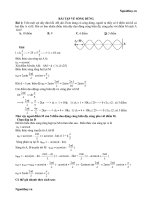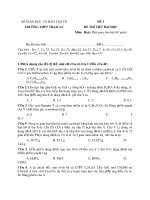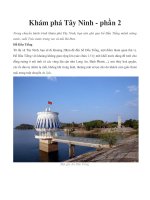Handout 2 pot
Bạn đang xem bản rút gọn của tài liệu. Xem và tải ngay bản đầy đủ của tài liệu tại đây (1.37 MB, 128 trang )
EC202A Macroeconomics
Handout 2
Laura Povoledo
The University of Reading
EC202A Macroeconomics
The IS-LM-BP model
Reading material that you may find useful:
-
Abel, Bernanke and McNabb, Chapters 5 and 14.
-
Abel, Bernanke, 5
th
ed, Chapters 5 and 13.
-
Dornbusch, Fisher and Startz, 9
th
ed, Chapter 12.
-
Begg, Fischer an Dornbusch, 7
th
ed, Chapters 28 and
29.
Outline:
1. The Goods Market Equilibrium in an Open
Economy ;
2. The open-economy IS curve ;
3. The Balance of Payments and Capital Flows ;
4. The BP curve ;
5. The Mundell-Fleming model .
The Goods Market Equilibrium in an Open
Economy
Economies are linked internationally through
two main channels:
•
trade in goods and services;
•
international financial markets.
First, let’s consider the effects of trade with
the rest of the world on the goods market
equilibrium and then we’ll understand how
to modify the IS curve.
The Goods Market Equilibrium in an Open
Economy
Previously, we have seen that the goods
market equilibrium condition can be
expressed in two ways:
1) National saving equals investment:
S = I
(1) Closed economy Equation
2) Aggregate supply equals aggregate demand:
Y = C + I + G (2) Closed economy Eq.
The Goods Market Equilibrium in an Open
Economy
What changes in an open economy?
National saving now has two uses:
•
increase the nation’s capital stock by domestic
investment;
•
increase the stock of net foreign assets by
lending to foreigners.
We capture this by re-writing the equilibrium
condition (1) in the following way:
S = I + CA
= I + NX + NFP
(1)’ Open economy Eq.
Change no. 1
The Goods Market Equilibrium in an Open
Economy
Eq. (1)’ shows the uses of savings in an open
economy. Investment I is accrued to the
domestic capital stock. The current account
balance CA indicates the amount of funds that
the country has available for net foreign
lending.
Hence, Eq. (1)’ states that in goods market
equilibrium in an open economy, the amount of
national saving S must equal the amount of
domestic investment I plus the amount lent abroad
CA.
The Goods Market Equilibrium in an Open
Economy
The closed economy equilibrium condition (1)
is a special case of the open economy
equilibrium condition (1)’, with CA =0.
Change no. 2
What else changes in an open economy?
Domestic spending on goods and
services is no longer equal to domestic output.
This happens because:
-
Part of domestic output is sold to foreigners
(exports);
-
Part of spending by domestic residents
purchases foreign goods (imports).
The Goods Market Equilibrium in an Open
Economy
We can also re-write the equilibrium
condition (2) - aggregate supply equals
aggregate demand – for an open economy.
The main change is that domestic spending
no longer determines domestic output.
Instead, spending on domestic goods
determines domestic output.
Define:
A = spending by domestic residents
Then:
A = C + I + G
The Goods Market Equilibrium in an Open
Economy
Spending on domestic goods is total spending
by domestic residents less their spending on
imports plus foreign demand or exports.
Therefore:
Where:
X = exports;
Q = imports.
Spending on domestic goods = A + NX =
= C + I + G + X – Q
= Domestic output
Note:
A is also called absorption.
The Goods Market Equilibrium in an Open
Economy
In order to obtain an equilibrium condition,
we write:
Y = C + I + G + NX (2)’ Open economy Equation
Eq. (2)’ states that in goods market equilibrium in an
open economy, the supply of domestic goods Y is
equal to spending on domestic goods, A + NX.
The Goods Market Equilibrium in an Open
Economy
What affects net exports NX?
•
Foreign output Y
F
(higher foreign output
increases X and NX)
•
Domestic output Y (higher domestic output
increases Q and decreases NX)
•
The real exchange rate (higher
means more exports and less imports)
P
Pe
e
FNOM
R
⋅
=
The open-economy IS curve
The IS curve shows the possible combinations of
the interest rate r and domestic output Y, for
which the goods market is in equilibrium.
In the closed economy, the IS curve can be
written as:
Meaning: the goods market is in equilibrium
when aggregate supply is equal to aggregate
demand for goods. Consumption depends on Y,
investment depends on r. We draw the IS line
(goods market equilibrium condition) in the (r,
Y) plane.
Y = C
(Y) + I(r) + G
AS = AD
The open-economy IS curve
In the open economy, the goods market
equilibrium condition becomes:
Or simply:
AS = AD
Y = C
(Y) + I(r) + G + NX(Y
F
, Y, )
Y = C
(Y) + I(r) + G + NX(Y)
P
Pe
FNOM
⋅
IS(r, Y)
Output, Y
r
The slope of the IS depends on
size of multiplier and the elasticity
of investment to domestic interest
rate (which is negative, hence the
negative slope of the IS).
The open-economy IS curve
The IS curve is shifted by changes in G, Y
F
and
the real exchange rate (we are assuming that
prices are fixed).
•
If then
•
If then
• If there is a real appreciation
then
r
Y
IS
Y
F
X
ADG
NX
The open-economy IS curve
•
If then
•
If then
•
If there is a real depreciation
then
r
Y
IS
Y
F
X
ADG
NX
Note: above the IS line AS > AD (aggregate
supply > aggregate demand).
Below, AS < AD.
LM - Money market equilibrium in the open
economy
LM
Y
r
M
D
> M
S
M
D
< M
S
LM slope depends on
elasticity of money
demand with respect
to interest rates: if
the latter is low then
LM is steep.
LM is upward sloping
because if income
increases money demand
increases and the interest
rate must increase as well.
The money supply is affected
by changes in e
NOM
under
fixed exchange rates, hence
the LM shifts if e
NOM
is
different from the target level
e
NOM
*. Under floating
exchange rates, the LM is not
affected by e
NOM
.
Balance of Payments
The Balance of Payments and Capital Flows
The Balance of Payments (from now on, BP) is
the record of transactions between one country
and the rest of the world.
The two main accounts in the BP are the current
account and the capital account:
The current account records trade in goods,
services, and transfer payments.
The capital account records the trade in assets.
Current Account Capital Account
The Balance of Payments and Capital Flows
Balance of payments accounts = The record of
a country’s international transactions.
Any transaction that involves a flow of money
into the UK is a credit item (enters with a
plus sign).
Any transaction involving a flow of money out
of the UK is a debit item (enters with a
minus sign).
The Balance of Payments and Capital Flows
The overall BP surplus or deficit is the sum of the
current and capital account surpluses or
deficits:
Since residents of a country must pay for what
they buy abroad, any current account deficit
must be necessarily financed by an offsetting
capital flow:
BP = CA + KA
BP = CA + KA = 0
Balance of Payments equilibrium
Investment income from abroad
The Balance of Payments and Capital Flows
But what are the economic forces that affect the
BP? To answer this question we must look at
each separate component of the BP.
For convenience we divide the current account
into 3 components:
NX
NT
NFP
Net exports of goods and services
Net unilateral transfers
CA
Note: NFP (Net factor payments) is almost (but not always)
equal to Investment income from abroad. Why?
Net exports depend on:
•
real exchange rate
•
the level of domestic income Y
•
the level of foreign income Y
F
The Balance of Payments and Capital Flows
P
Pe
e
FNOM
R
⋅
=
What determines CA = NX ?
P
Pe
FNOM
P
Pe
FNOM
In general, NFP and NT are not much affected
by current macroeconomic developments.
From now on, we assume them to be equal to 0
for simplicity.
We write: CA = X(Y
F,
) - Q(Y
,
)
The Balance of Payments and Capital Flows
•
A rise in foreign income increases exports:
• A real depreciation improves net exports:
•
A rise in domestic income increases imports:
So the CA is a function of 3 variables:
The real exchange rate measures a
country's competitiveness in foreign trade. If prices
stay fixed then e
R
and e
NOM
(real and nominal
exchange rate respectively) always move in the same
direction.
P
Pe
e
FNOM
R
⋅
=
Y
F
CA
Y
CA
CA
P
Pe
FNOM
CA(Y
F
, Y, )
P
Pe
FNOM
The Balance of Payments and Capital Flows
Again, we look first at the separate components.
It is often useful to split the capital account into
two separate components: (1) the transactions
of the country’s private sector and (2) official
reserve transactions, which correspond to the
central bank activities:
What about the KA ?
KA
Net private capital inflows
Official reserve transactions
NPKI
ORT
The Balance of Payments and Capital Flows
Private residents selling off
assets abroad or
borrowing abroad.
Example: a current account deficit (CA < 0) can be
financed in two ways:
The central bank sells
foreign currency and buys
home currency.
Exercise: what are the implications of the two options
above for the capital account KA?









